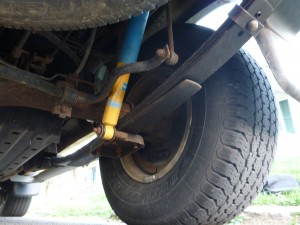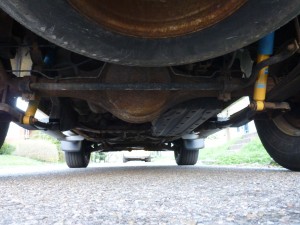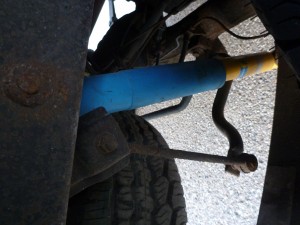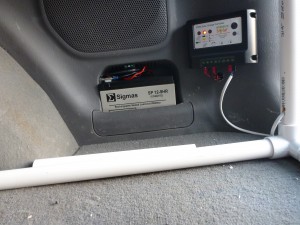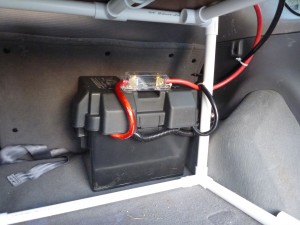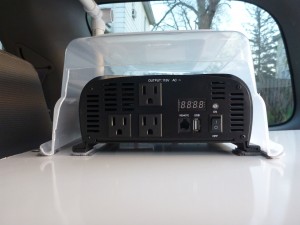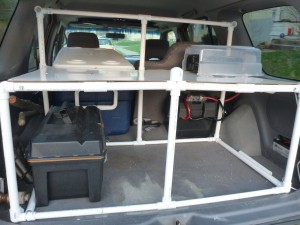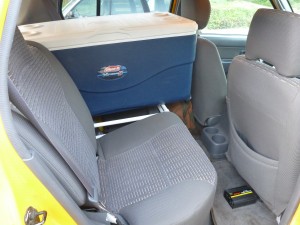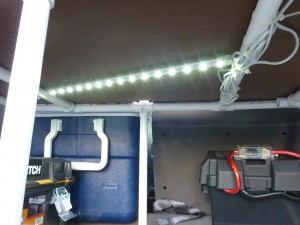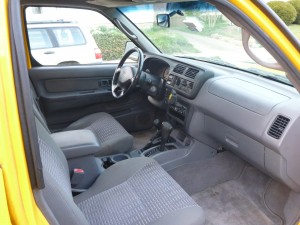Salamandermobile
I will basically be living out of my 2000 Nissan Xterra from May-August. Therefore I wanted to make sure that the vehicle was prepared for a summer of field work. This meant replacing a broken leaf spring and my front and rear shocks.
Another big issue I will need to deal with this summer is a lack of some of the technology that makes doing research a bit easier. Things that I can not really avoid will be a lack of cell service or internet at most field sites. This is not a huge deal as I can go to coffee shops in nearby towns and back up data and contact people when it is necessary. The real issue I needed to address was a lack of electricity. Could I get away without electricity during most of the summer? Yes. However, it would make the work much more cumbersome and I would also be at a greater risk of losing data. Most of my field gear needs to be charged or takes batteries such as my flashlights, headlamps, temperature probe, moisture meter, and GPS. I could theoretically carried a bunch of batteries with me, but that would have been a pretty big waste of batteries. I also have a cell phone and laptop, both of which I will want to use to enter data and use important software such as ArcGIS. They also help add some distractions after working in the forest all day, especially when I will have two field assistants all summer long. I think it is especially important to make field assistants watch slasher horror movies with a camping theme right before we go to sleep while camping.
So in order to help alleviate this problem I made a few modifications to my vehicle. One, I added a solar panel system. This is hooked to a 400 watt inverted which is wired under the passenger seat. The battery and controller are stored in the back of the car (first photo below) with the connection for the solar panel set near the roof so I can store the solar panel when not in use and easily set it up when I want to charge the battery. Secondly, I had a Optima Yellowtop battery installed (second photo below) which is charged off the alternator and also directly linked to both DC outlets. I also added a 1200 watt inverter (third photo below) connected directly to the battery. The plastic cover I added should have proper ventilation for the inverter but still protect it from any water or dirt that gets into the car when loading gear. This setup should offer my assistants and myself enough electricity to keep our cell phones, laptop, and field gear charged all summer long.
I also added in some PVC shelves (first photo below). If I knew what I was doing they would probably be a little nicer, but they should get the job done. I was also able to hook up an LED light strip (third photo below) to the underside of the shelf which hooks directly to the solar panel battery. The main purpose of the PVC shelving is to help keep gear organized all summer long. The biggest problem I have had, even on short trips, is that gear starts out well organized and quickly gets jumbled as the work progresses. I am hoping to avoid that as much as possible this summer. In the second picture below you can see the 400 watt inverter under the passenger seat that is hooked to the solar panel system. That photo also shows the mini PVC compartment I created to prop up the cooler and add a bit of extra storage space. If it is not obvious, I removed the back seat on the drivers side. This adds some extra storage space and was easy to remove ( and will be easy to reattach later).
Finally, I cleaned up the car a bit, which is mostly just to have a clean start since I know it will become filthy during the course of the summer. I also attached my reviewer mirror that was knocked off 3 years ago and also scrapped off all the old parking and registration stickers from the drive side windshield. Now all that’s left is to see how well this vehicle works this summer!

